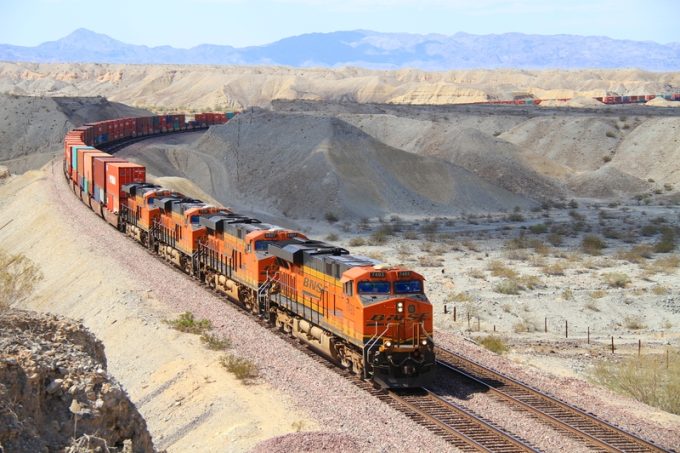US logistics players expand to boost their cross-border reach into Mexico
US surface logistics providers are expanding their reach across the southern border. Class I rail carriers ...
BA: WIND OF CHANGEMAERSK: BULLISH CALLXPO: HEDGE FUNDS ENGINEF: CHOPPING BOARDWTC: NEW RECORDZIM: BALANCE SHEET IN CHECKZIM: SURGING TGT: INVENTORY WATCHTGT: BIG EARNINGS MISSWMT: GENERAL MERCHANDISEWMT: AUTOMATIONWMT: MARGINS AND INVENTORYWMT: ECOMM LOSSESWMT: ECOMM BOOMWMT: RESILIENCEWMT: INVENTORY WATCH
BA: WIND OF CHANGEMAERSK: BULLISH CALLXPO: HEDGE FUNDS ENGINEF: CHOPPING BOARDWTC: NEW RECORDZIM: BALANCE SHEET IN CHECKZIM: SURGING TGT: INVENTORY WATCHTGT: BIG EARNINGS MISSWMT: GENERAL MERCHANDISEWMT: AUTOMATIONWMT: MARGINS AND INVENTORYWMT: ECOMM LOSSESWMT: ECOMM BOOMWMT: RESILIENCEWMT: INVENTORY WATCH

Divisions remain deep between US rail labour and management, with accusations that the latter is jeopardising safety for the benefit of profitability.
At Burlington Northern Santa Fe (BNSF) the Brotherhood of Maintenance of Way Employees division of the Teamsters Union has written to the US Surface Transportation Board (STB) warning that cutbacks in the railway’s maintenance budget are undermining safety to shore up profits.
US rail top brass and labour are also sharply divided on the safety risks associated with long trains.
The Teamster’s letter to the STB argues that BNSF’s decision to cut $105m from its 2024 capital maintenance plan, resulting in the deferral of maintenance and infrastructure projects, was due to management’s “pursuit of a lower operating ratio” to satisfy investors.
It describes the cutbacks as a reflection of a “disturbing trend” in the industry.
“Maintenance of way work is not discretionary; it is an ongoing requirement that should not be compromised for short-term financial gains,” the union argues in its submission to the regulator, adding that “the proposed cuts demonstrate that BNSF is prioritising immediate cost savings over the necessary and continuing maintenance program that is fundamental to safe and effective railroad operations, as well as the railroad’s capacity for growth.”
The submission comes ahead of a two-day hearing scheduled by the STB to examine the Class I railways’ investment and growth plans.
BNSF management has claimed that neither safety nor service would be substantially affected by the cuts.
This is the second time this year that rail labour unions have approached US regulators over cutbacks at BNSF, accusing its management of jeopardising safety and performance. In March, the Transportation Trades Department with the American Federation of Labor and Federation of Industrial Organizations asked the Federal Rail Administration (FRA) to impose unscheduled inspections of BNSF trains after reports that the carrier had furloughed more than 360 employees at terminals in Kansas, Montana, Nebraska and Texas.
“We urge the FRA to immediately conduct unannounced focused inspections of all BNSF-owned and leased locomotives and rail cars […] and further issue non-compliance orders requiring BNSF to repair any defects before being permitted to utilise their locomotives and rail cars,” the union wrote.
It also expressed “concerns about numerous defects that are intentionally being ignored and neglected by BNSF”.
BNSF commented that the furloughs were implemented to address an imbalance of employees in the network that were under-employed while other areas were short of manpower, and that it had offered location transfers with incentives. However, according to the union, employees who took the offer would lose their seniority status, pushing them down the career ladder.
A study to examine the safety of long trains, of over 7,500 feet, produced by the National Academies of Science, published yesterday, has not bridged the gap between the two sides on safety.
The authors found there was no threshold at which a “manifest train” – made up of mixed rail cars – becomes a “long train”, but that management of in-train forces becomes more complex. They recommend that major carriers should work together with the FRA and Congress to address the issues involved.
The report calls on the FRA to tighten requirements so railways identify, analyse and address the risks associated with major operational changes, and says they should be required to monitor and evaluate the effectiveness of these measures on a regular basis.
Neither side is totally satisfied with the report – although some comments suggest they may have read different papers.
The Brotherhood of Railroad Engineers and Trainmen views it as a confirmation of its position that long trains have a greater risk of derailing, breaking down and causing congestion. But that it also dismisses its recommendation for further studies and the hiring of auditors by Congress. Instead of waiting, all major carriers should immediately adopt the confidential reporting system for employees to raise the alarm about safety issues, it argued, calling the inaction on this issue proof that “safe rail service is often nothing more than lip service”.
The Association of American Railroads, meanwhile, found “several shortcomings” in the report, beginning with its “arbitrary” focus on trains in excess of 7,500ft in length.
“The […] study does not demonstrate data supporting any claims that manifest trains exceeding 7,500ft pose additional operational safety risks. Any effort to impose a prescriptive train length limit would be both irresponsible and unfounded,” the rail interest group commented.
Cargo owners will find little comfort in the fact that rail management and labour appear to share little common ground on safety.
Comment on this article